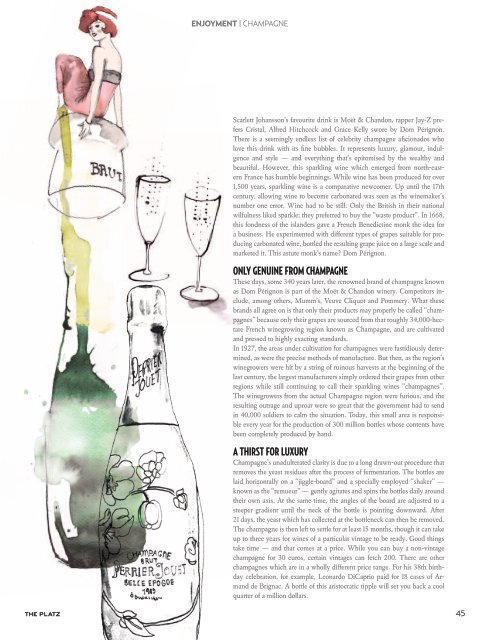the platz
Sie wollen auch ein ePaper? Erhöhen Sie die Reichweite Ihrer Titel.
YUMPU macht aus Druck-PDFs automatisch weboptimierte ePaper, die Google liebt.
ENJOYMENT | Champagne<br />
Scarlett Johansson’s favourite drink is Moët & Chandon, rapper Jay-Z prefers<br />
Cristal, Alfred Hitchcock and Grace Kelly swore by Dom Pérignon.<br />
There is a seemingly endless list of celebrity champagne aficionados who<br />
love this drink with its fine bubbles. It represents luxury, glamour, indulgence<br />
and style — and everything that’s epitomised by <strong>the</strong> wealthy and<br />
beautiful. However, this sparkling wine which emerged from north-eastern<br />
France has humble beginnings. While wine has been produced for over<br />
1,500 years, sparkling wine is a comparative newcomer. Up until <strong>the</strong> 17th<br />
century, allowing wine to become carbonated was seen as <strong>the</strong> winemaker’s<br />
number one error. Wine had to be still. Only <strong>the</strong> British in <strong>the</strong>ir national<br />
wilfulness liked sparkle; <strong>the</strong>y preferred to buy <strong>the</strong> “waste product”. In 1668,<br />
this fondness of <strong>the</strong> islanders gave a French Benedictine monk <strong>the</strong> idea for<br />
a business. He experimented with different types of grapes suitable for producing<br />
carbonated wine, bottled <strong>the</strong> resulting grape juice on a large scale and<br />
marketed it. This astute monk’s name? Dom Pérignon.<br />
Only genuine from Champagne<br />
These days, some 340 years later, <strong>the</strong> renowned brand of champagne known<br />
as Dom Pérignon is part of <strong>the</strong> Moët & Chandon winery. Competitors include,<br />
among o<strong>the</strong>rs, Mumm’s, Veuve Cliquot and Pommery. What <strong>the</strong>se<br />
brands all agree on is that only <strong>the</strong>ir products may properly be called “champagnes”<br />
because only <strong>the</strong>ir grapes are sourced from that roughly 34,000-hectare<br />
French winegrowing region known as Champagne, and are cultivated<br />
and pressed to highly exacting standards.<br />
In 1927, <strong>the</strong> areas under cultivation for champagnes were fastidiously determined,<br />
as were <strong>the</strong> precise methods of manufacture. But <strong>the</strong>n, as <strong>the</strong> region’s<br />
winegrowers were hit by a string of ruinous harvests at <strong>the</strong> beginning of <strong>the</strong><br />
last century, <strong>the</strong> largest manufacturers simply ordered <strong>the</strong>ir grapes from o<strong>the</strong>r<br />
regions while still continuing to call <strong>the</strong>ir sparkling wines “champagnes”.<br />
The winegrowers from <strong>the</strong> actual Champagne region were furious, and <strong>the</strong><br />
resulting outrage and uproar were so great that <strong>the</strong> government had to send<br />
in 40,000 soldiers to calm <strong>the</strong> situation. Today, this small area is responsible<br />
every year for <strong>the</strong> production of 300 million bottles whose contents have<br />
been completely produced by hand.<br />
A thirst for luxury<br />
Champagne’s unadulterated clarity is due to a long drawn-out procedure that<br />
removes <strong>the</strong> yeast residues after <strong>the</strong> process of fermentation. The bottles are<br />
laid horizontally on a “jiggle-board” and a specially employed “shaker” —<br />
known as <strong>the</strong> “remueur” — gently agitates and spins <strong>the</strong> bottles daily around<br />
<strong>the</strong>ir own axis. At <strong>the</strong> same time, <strong>the</strong> angles of <strong>the</strong> board are adjusted to a<br />
steeper gradient until <strong>the</strong> neck of <strong>the</strong> bottle is pointing downward. After<br />
21 days, <strong>the</strong> yeast which has collected at <strong>the</strong> bottleneck can <strong>the</strong>n be removed.<br />
The champagne is <strong>the</strong>n left to settle for at least 15 months, though it can take<br />
up to three years for wines of a particular vintage to be ready. Good things<br />
take time — and that comes at a price. While you can buy a non-vintage<br />
champagne for 30 euros, certain vintages can fetch 200. There are o<strong>the</strong>r<br />
champagnes which are in a wholly different price range. For his 38th birthday<br />
celebration, for example, Leonardo DiCaprio paid for 18 cases of Armand<br />
de Brignac. A bottle of this aristocratic tipple will set you back a cool<br />
quarter of a million dollars.<br />
45


